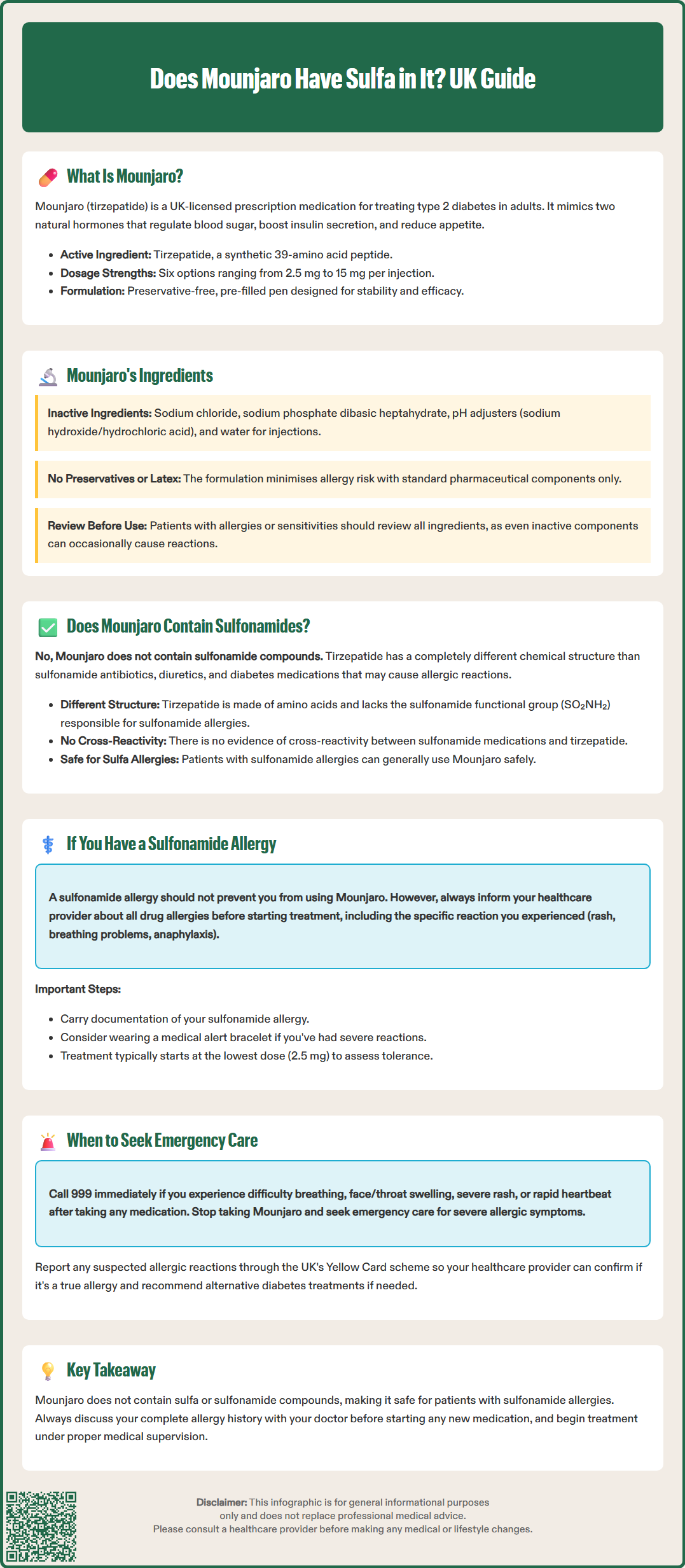LOSE WEIGHT WITH MEDICAL SUPPORT — BUILT FOR MEN
- Your personalised programme is built around medical care, not willpower.
- No generic diets. No guesswork.
- Just science-backed results and expert support.
Find out if you’re eligible

Many patients prescribed Mounjaro (tirzepatide) for type 2 diabetes wonder whether it contains sulfonamides, particularly if they have a known sulfa allergy. Mounjaro does not contain sulfonamide compounds. This distinction is important for safe prescribing and patient confidence. Tirzepatide is a dual GIP and GLP-1 receptor agonist composed of a synthetic peptide without the sulfonamide functional group found in certain antibiotics, diuretics, and sulphonylureas. Understanding Mounjaro's complete ingredient profile helps clinicians and patients make informed treatment decisions, especially when managing medication allergies and sensitivities.
Quick Answer: Mounjaro (tirzepatide) does not contain sulfonamide compounds and is safe for patients with sulfonamide allergies.
Mounjaro (tirzepatide) is a prescription medicine licensed in the UK for the treatment of type 2 diabetes mellitus in adults. It belongs to a novel class of medications known as dual glucose-dependent insulinotropic polypeptide (GIP) and glucagon-like peptide-1 (GLP-1) receptor agonists. Tirzepatide works by mimicking the action of two naturally occurring incretin hormones that help regulate blood glucose levels, enhance insulin secretion when blood sugar is elevated, and reduce appetite.
The active pharmaceutical ingredient in Mounjaro is tirzepatide, a synthetic peptide consisting of 39 amino acids. Each pre-filled pen contains tirzepatide at varying strengths (2.5 mg, 5 mg, 7.5 mg, 10 mg, 12.5 mg, or 15 mg per 0.5 mL injection). The formulation also includes several excipients that maintain the medication's stability and efficacy.
Key excipients in Mounjaro include:
Sodium chloride (maintains isotonicity)
Sodium phosphate dibasic heptahydrate (buffering agent)
Sodium hydroxide and/or hydrochloric acid (pH adjusters, as required)
Water for injections
These inactive ingredients are standard pharmaceutical components used in many injectable medications. The formulation is preservative-free. Understanding the complete composition of Mounjaro is essential for patients with known allergies or sensitivities, as even inactive ingredients can occasionally trigger adverse reactions in susceptible individuals. The Medicines and Healthcare products Regulatory Agency (MHRA) requires comprehensive labelling of all ingredients to support informed prescribing and patient safety.
For the full list of excipients, please refer to the Summary of Product Characteristics (SmPC) available on the Electronic Medicines Compendium (EMC) website.
Mounjaro does not contain sulfonamide compounds. This is an important distinction for patients with known sulfonamide allergies who may be concerned about potential cross-reactivity or allergic reactions. Sulfonamides are a class of medications that contain a sulfonamide functional group (SO₂NH₂), which includes certain antibiotics (such as co-trimoxazole), some diuretics (like furosemide), and specific oral diabetes medications (particularly sulphonylureas).
Tirzepatide, the active ingredient in Mounjaro, is a peptide-based molecule with a completely different chemical structure. It does not contain the sulfonamide moiety responsible for sulfonamide-related allergic reactions. The medication's molecular composition consists of amino acids linked together in a specific sequence, without the sulfonamide functional group characteristic of sulfonamide drugs.
Important clarification: It is worth noting that sulfonamide allergies are specific to the sulfonamide chemical structure in certain medications. These allergies are distinct from sensitivities to elemental sulphur, sulfates, or sulfites, which are chemically different substances. Patients with sulfonamide allergies do not necessarily react to all sulphur-containing compounds.
According to the UK Specialist Pharmacy Service guidance, there is no evidence to suggest that patients with sulfonamide allergies would experience cross-reactivity with non-sulfonamide medications like tirzepatide. Patients with documented sulfonamide allergies can generally use Mounjaro safely, though all new medications should be initiated under appropriate medical supervision. If you have concerns about drug allergies, discuss your complete allergy history with your prescribing clinician before starting treatment.

If you have a documented sulfonamide allergy, it is essential to inform your healthcare provider about this before starting any new medication, including Mounjaro. A comprehensive allergy history helps clinicians make informed prescribing decisions and implement appropriate monitoring strategies. However, as established, Mounjaro does not contain sulfonamide compounds, so a sulfonamide allergy should not contraindicate its use.
Steps to take if you have a sulfonamide allergy:
Inform your GP or diabetes specialist about all known drug allergies, including the specific reaction you experienced (rash, breathing difficulties, anaphylaxis)
Distinguish between true allergies and intolerances – some adverse effects are side effects rather than allergic reactions
Carry documentation of your allergy, ideally wearing a medical alert bracelet if you have experienced severe reactions
Review your medication list regularly with your pharmacist to identify any sulfonamide-containing drugs
When starting Mounjaro, your healthcare provider will assess your suitability based on your complete medical history, including any history of allergic reactions to medications. The first dose is typically administered at the lowest strength (2.5 mg) to assess tolerability, as recommended in the SmPC. Patients should be educated about recognising signs of allergic reactions.
When to seek immediate medical attention:
Difficulty breathing or swallowing
Swelling of the face, lips, tongue, or throat
Severe skin rash or hives
Rapid heartbeat or dizziness
If you experience symptoms of a severe allergic reaction, call 999 or go to A&E immediately. For less severe but concerning symptoms, contact your GP or diabetes care team promptly for assessment.
According to NICE guidance on type 2 diabetes management (NG28), patient safety and individualised treatment approaches are paramount when selecting glucose-lowering therapies.
Understanding the complete ingredient profile of Mounjaro is crucial for identifying potential allergens and ensuring safe medication use. Beyond the active ingredient tirzepatide, the formulation contains several excipients that serve specific pharmaceutical functions.
Mounjaro ingredients according to the UK SmPC:
Tirzepatide (active ingredient) – the therapeutic peptide
Sodium chloride – maintains appropriate osmolality
Sodium phosphate dibasic heptahydrate – pH buffer to maintain stability
Sodium hydroxide and/or hydrochloric acid – pH adjusters (as required)
Water for injections – sterile solvent
This relatively simple, preservative-free formulation minimises the risk of allergic reactions compared to more complex preparations. According to the Patient Information Leaflet (PIL), the pen components do not contain natural rubber latex, which is relevant for patients with latex allergies.
Allergy considerations for Mounjaro:
Hypersensitivity reactions to tirzepatide have been reported, as noted in the Summary of Product Characteristics (SmPC). These may manifest as rash, itching, or in some cases, more serious reactions. The frequency of such reactions should be discussed with your healthcare provider.
Patients with a history of allergic reactions to other medications, including other GLP-1 receptor agonists, should discuss this with their clinician. While the potential for cross-reactivity between different GLP-1 receptor agonists is not well established, your healthcare provider can help assess individual risk based on your medical history.
If you experience symptoms suggestive of an allergic reaction while taking Mounjaro, discontinue the medication and seek medical advice promptly. For severe reactions with breathing difficulties or facial swelling, call 999 or go to A&E immediately. For less urgent concerns, contact your healthcare provider.
The MHRA encourages reporting of suspected adverse drug reactions, including allergic responses, through the Yellow Card scheme (yellowcard.mhra.gov.uk). Your healthcare provider can assess whether the reaction is truly allergic in nature and recommend alternative diabetes treatments if necessary.
Yes, Mounjaro does not contain sulfonamide compounds, so a sulfonamide allergy should not contraindicate its use. However, always inform your prescriber of all known drug allergies before starting treatment.
Mounjaro contains tirzepatide as the active ingredient, plus excipients including sodium chloride, sodium phosphate dibasic heptahydrate, sodium hydroxide and/or hydrochloric acid (pH adjusters), and water for injections. It is preservative-free and does not contain latex.
For severe reactions such as difficulty breathing, facial swelling, or severe rash, call 999 or go to A&E immediately. For less urgent symptoms, discontinue Mounjaro and contact your GP or diabetes care team promptly for assessment.
All medical content on this blog is created based on reputable, evidence-based sources and reviewed regularly for accuracy and relevance. While we strive to keep content up to date with the latest research and clinical guidelines, it is intended for general informational purposes only.
DisclaimerThis content is not a substitute for professional medical advice, diagnosis, or treatment. Always consult a qualified healthcare professional with any medical questions or concerns. Use of the information is at your own risk, and we are not responsible for any consequences resulting from its use.